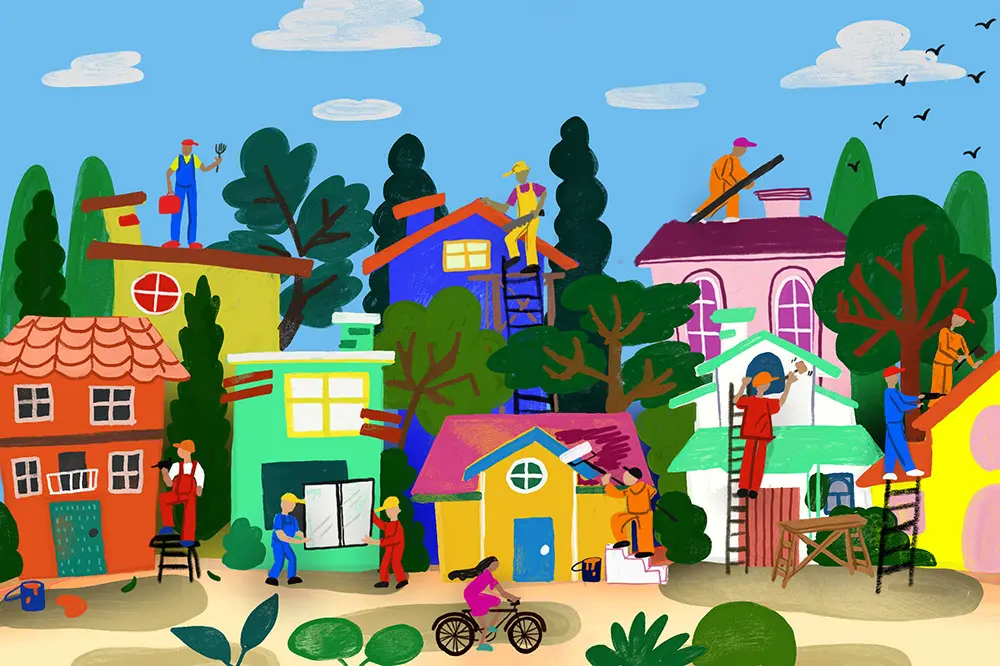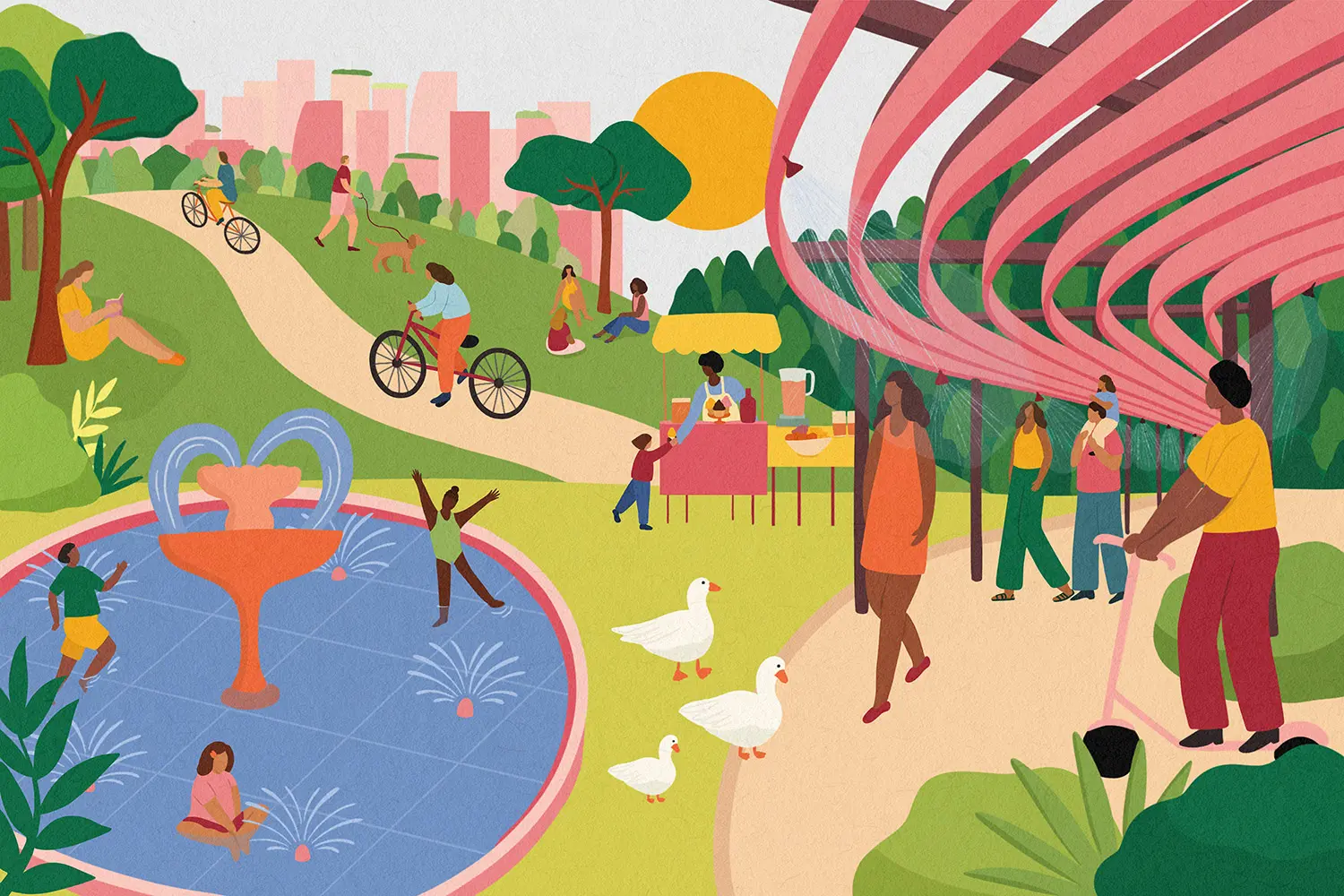Climate resilience as Community Gathering Spaces
Community Gathering Spaces are a powerful tool to:

What are community gathering spaces?
Community gathering spaces are the well-loved places where people naturally congregate. The term “community gathering spaces” is intentionally broad because these spaces look different from community to community. They might include libraries, parks, stoops, corner diners, coffee shops, schools, playgrounds, performance spaces, community gardens, houses of worship, youth centers, bars, barbershops, bowling alleys, bookstores, and on and on. In this context, we’re loosely defining community gathering spaces as:
- Places that folks visit or engage with on a semi-regular basis;
- Places where folks might meet up with friends to casually hang out but could also feel comfortable going alone;
- Places with low or no barrier to entry; and
- Places that are/feel safe and welcoming for all kinds of people.
Sociologist Ray Oldenburg (who’s particularly focused on commercial establishments) refers to these spaces as “third places,” or the places that people spend the most time beyond the home and school or the workplace. Sociologist Eric Klinenberg (who’s particularly focused on civic institutions and public spaces) describes them as the building blocks of public life, providing the scaffolding for folks to interact organically and for relationships to take root. Indeed, all types of community gathering spaces are foundational to cultivating human connections and a sense of community, and therefore are foundational to all community-based climate resilience strategies!
Resilience efforts often focus on improving hard infrastructure- roads, bridges, and other physical infrastructure- to the detriment of social infrastructure, the services and facilities that secure the economic, health, cultural, and social well-being of the community. Asian Pacific Environmental Network, Service Employees International Union, and BlueGreen Alliance (Resilience Before Disaster: The Need to Build Equitable, Community-Driven Social Infrastructure)
Some additional context: For numerous economic, political, cultural, and technological reasons, social infrastructure has been declining across the so-called United States for decades. Depending on who you ask, people point to suburban sprawl and zoning issues, retail giants pushing out small businesses and eroding Main Streets (see: The Walmart Effect), advances in technology, e-commerce, and social media, escalating real estate prices, the rise in economic inequality and the self-segregation of the rich, disinvestment in public services, shifts in values, the high barrier to entry at many commercial establishments that were once considered “third places,” the heightened policing of lingering and loitering, and more. The Covid-19 pandemic unfortunately accelerated many of these trends.
Given the decline in both quality and quantity of community gathering spaces, embracing these spaces as a climate resilience solution means:
- Working to revive and preserve existing social infrastructure;
- Where possible, finding ways to bring community gathering spaces into long-term, collective stewardship (Cooperatives! Land trusts! Public ownership!);
- Investing time, energy, wisdom, and resources into existing spaces to ensure that they are as accessible, inviting, and physically resilient as possible, and to expand their capacity to meet community needs during extreme weather and disasters;
- Transforming existing institutions into true community gathering spaces, as defined above;
- Creating new, place-based gathering spaces to meet the needs and desires of the community that aren’t currently being met; and
- Addressing many of the root issues mentioned above, particularly as they manifest locally.
Why it’s a climate resilience powerhouse:
Boosting quality of life, sense of belonging, and well-being
Neighborhoods brimming with spaces for community members to gather are generally more sociable, exciting, beautiful, accessible, and inclusive. Community gathering spaces can help folks to fill free time in meaningful and enjoyable ways and create pockets of joy, rest, and connection in between the workday or schoolday and sleep. They can help to ward off loneliness and isolation. They can help retain young people who might otherwise leave for places where there’s “more to do.” They can be a lifeline and respite from difficult living situations. And on and on.
Community gathering spaces that endure over time can also help to establish a community’s sense of place and culture. They make home feel more like home.
“We can do better than simple sea walls and reservoirs. If we make social infrastructure a part of our climate security strategy, we’ll not only be safer in the next disaster, we’ll be better off every day.” -public sociologist Eric Klinenberg (source)
Continue readingWe can do better than simple sea walls and reservoirs. If we make social infrastructure a part of our climate security strategy, we’ll not only be safer in the next disaster, we’ll be better off every day. Eric Klinenberg, public sociologist (source)
Establishing trustworthy, safe havens
When disaster hits or extreme weather intensifies, places that are familiar and inviting make the best refuges. Certain types of community gathering spaces are particularly well positioned to serve as havens and hubs during climate-related disasters and extreme weather, including (but not limited to):
Libraries: Libraries have incredible potential to become hubs of community support during extreme weather events and disasters. They already serve as a safe and accessible daytime refuge for so many, including folks experiencing homelessness, and therefore libraries are typically already adept at connecting folks to social services, legal assistance, food and housing referrals, and more- all of which are frequently needed in the wake of disaster.
Second of all, while few people want to leave the familiarity and comfort of their homes during an extreme weather event or disaster, most people find libraries to be welcoming, accessible, and friendly (over 90% according to a 2015 Pew survey!) and that makes a big difference when deciding whether to stay or go somewhere safer.
Building retrofits such as energy efficiency measures, onsite renewable energy generation, and energy storage can help ensure that libraries can provide air-conditioning, heating, power, and other forms of support to community members through extreme weather and/or power outages.
Other awesome resilience co-benefits include:
- Cultivating intergenerational community; they foster connection organically by providing a social space and extensive programming for young children, elders, and everyone in between. Friendships and support networks emerge from book clubs, story hours, movie nights, music classes, sewing circles, volunteer shifts, and more;
- Helping to fill some of the gaps as social and health services struggle to meet demand during extreme weather events and climate-related disasters. Many libraries already servie as ad hoc childcare and support for families and caretakers, offer free limited healthcare screening services and health-related programming, have social workers on staff to help address the needs of visitors, and/or have trained librarians to help visitors navigate health insurance, aging and mental health resources, and more.
Parks and gardens: Parks and gardens are an incredible source of relief on hot days. Parks and gardens with ample tree canopy coverage and vegetative cover on the ground help to substantially cool temperatures through shading and evapotranspiration. On top of that, the difference between park temperatures and the surrounding area generates what’s known as a “park breeze.” Particularly for folks who live in cities and lack consistent access to air conditioning, green spaces are life-saving.
There are numerous other resilience co-benefits, too, such as:
- Absorbing water; when designed thoughtfully, with features like bioswales, rain gardens, and retention basins, parks can help absorb water from rain and/or storm surge flooding;
- Sequestering carbon dioxide and producing oxygen;
- Supporting biodiversity by providing habitat and filtering the air, water, and soil;
- Sometimes producing food and plant medicine;
- Reducing acute stress and providing widespread health benefits for community members;
- Helping children develop positive and meaningful relationships with nature and the more-than-human world;
- Bolstering interaction between neighbors, social cohesion, and neighborhood provide;
- And more!
If you have a garden and a library, you have everything you need. Cicero
Houses of worship: Religious congregations are obvious havens for community members during disaster. For one, they’re everwhere. Eric Klinenberg explains, “People who do disaster planning have already identified religious organizations as key first responders and linchpins of community resilience — in part because they are ubiquitous. In the United States, there are more than 300,000 religious congregations.” Communities without much other social infrastructure will still often have a church, mosque, synagogue, or other physical space associated with a religious group.
Plus, many houses of worship are equipped with industrial kitchens, childcare rooms, and gathering places. Some even have housing. Many already offer guidance and counseling to help folks navigate difficult transitions (which are rampant during climate disasters). They can easily contact and check in on congregation members. And they are often set up to mobilize volunteers at a moment’s notice. In short, houses of worship have a lot of physical and social infrastructure that can be put to use to help feed, house, convene, and guide community members during and after climate events.
Affinity spaces: Many communities impacted by structural oppression and marginalization are both particularly vulnerable during climate-related disasters and particularly experienced in creating sanctuary spaces. Therefore, safe spaces created by and for these communities- queer and trans folks, disabled folks, undocumented folks, etc.- are vital to ensuring that nobody gets left behind during and after climate events (and yearround!).
Continue readingThe nuance / caveats:
There’s a lot to keep in mind when considering how to preserve, transform, and introduce new community gathering spaces to optimize for climate resilience:
- Many of the most important (and least glamorous) community gathering spaces are perpetually underinvested in and cash-strapped. Before expecting institutions like libraries and schools (and the people who work in them) to take on even more community roles than they already fill, make sure that they’re being adequately resourced and valued.
- As much has been discussed about the decline of community gathering spaces in recent decades, it’s important to note that, historically, many gathering spaces beloved by some have been off-limits, hostile, or inaccessible to others. Becoming a hub for community resilience also means committing to stand up against discriminatory practices and narratives, advocating for liberation and justice for all, working to heal historical harms, and striving to make all community members feel safe and welcome.
- It’s not always safe or feasible for folks to be together in-person (particularly during a pandemic, and particularly for disabled folks). Having physical spaces for community members to gather is important, and nurturing online spaces and other strategies for community connection and care is important, too!
- Gathering spaces that work well for one community may not work for another.
- It’s shockingly easy to create communal spaces that do not attract people. Check out Project for Public Spaces’s Eleven Principles for Creating Community Places for guidance to avoid common pitfalls. First on the list- the community is the expert!
- New community spaces may trigger gentrification, displacement, and other forms of harm. Therefore, once again, it is crucial that new projects are truly for the community and by the community. Eric Klinenberg also notes that most communities would benefit from fewer massive, high-cost initiatives and more investments in existing infrastructure and small-scale parks, gardens, and the like.
Research + reflection prompts:
- Where do you feel most connected to your community/communities? Where do you feel the safest? The most supported?
- Do those community gathering spaces need investment/advocacy to survive and thrive for decades to come? Have they called for specific forms of support? What might be needed for the space to become a hub or haven during climate disasters?
- Take a moment to envision what doesn’t already exist. What might your ideal community gathering space entail? What sensations do you experience when you’re there? What does it look, sound, smell, taste, feel like?
How to get engaged:
Organize climate-related disasters support
If you’re engaged in a faith-based community: Strategize and prepare with members of your house of worship so that your synagogue, mosque, temple, or church can serve as a hub of support for the local community before, during, and after climate-related disasters. Consider how you might tap into the house of worship’s facilities, congregation, and other assets to provide hot meals, childcare, counseling, bodywork, a place for folks to sleep, a site for supply storage and/or distribution, and so on. Might it be possible to equip the building with renewable energy generation or storage to provide heating, cooling, and power amid a power outage? To get started, check out organizations like Creation Justice Ministries, which has a robust climate resilience initiative geared towards Christian communities, and Communities Responding to Extreme Weather (CREW), which hosts an annual Interfaith Summit.
Support local libraries
If you’re a lover of libraries: Support continued investment in your local library by signing up for a membership card or dusting off the one you already have, joining your local Friends of the Library chapter, contacting your representatives to share the value of the library in your life, attending programming and events, and shopping at their book sales. If you work or volunteer at the library, explore the American Library Association’s Resilient Communities Programming Guide to weave more climate education into film and book clubs, community dialogues, and afterschool offerings. Explore the Sustainable Libraries Initiative for resources on transforming your library into a climate resilience hub. Consider which retrofits, updates, and additional investments would be needed for your library to continue offering community services during and after the disasters most likely to impact your neighborhood.
Connect community spaces
If you’re deeply engaged in another community space: Team up with others to consider how you might elevate the space to become a hub for resilience and mutual aid. Think outside the box: art studios, urban farms, community centers, cafés, and brick-and-mortar stores can all be equipped to meet various community needs during and after disasters—and to serve as a gathering spot for folks to connect, strategize, and build people power year-round. Check out free resources like Shareable’s The Resilience We Want guide, and the Guide to Developing Resilience Hubs created by the Urban Sustainability Directors Network. Think big and start small.
Advocate for spaces
If you work in city planning, architecture, development, or design (or are simply an engaged community member with a bit of free time!): Advocate for the development of safe and accessible community spaces where all kinds of people can gather, or invest in existing spaces that already serve this purpose. Are there any places that are currently being underutilized, like vacant lots or parking spaces, that might instead enhance the physical, emotional, and social well-being of the neighborhood? (If you live in NYC, check out the Living Lots NYC tool created by the 596 Acres project!) Strive to maximize climate mitigation, adaptation, and justice co-benefits as much as possible. Conduct deep and meaningful community engagement so that current residents, and particularly those most impacted by structural oppression, are in the driver’s seat of the project.
A smattering of resources for continued learning + action:
Short Reads
- “Want to Survive Climate Change? You’ll Need a Good Community” by Eric Klinenberg in Wired
- “Op-Ed: Social infrastructure can help save us from the ravages of climate change” by Eric Klinenberg in Los Angeles Times
- “‘Third places’ as community builders” by Stuart M. Butler and Carmen Diaz in Brookings
- “What can warm banks teach us about spatial justice?” By Isabella Yasmin Kajiwara in Shado Mag
- “Do Yourself a Favor and Go Find a ‘Third Place’” by Allie Conti in The Atlantic
- “Why Libraries Are Essential to Climate Justice” by Sarah Sax in Yes Magazine
- “Worry Less About Crumbling Roads, More About Crumbling Libraries” by Eric Klinenberg in The Atlantic
- “Next Time, Libraries Could Be Our Shelters From the Storm” by Michael Kimmelman in The New York Times
- “They’re turning churches into climate-resilience centers” by Brianna Baker in Fix Solutions Lab
Guides & Reports
- “Placemaking: What If We Built Our Cities Around Places?” by Project for Public Spaces
- “For Whom, By Whom: Vol. 1” by Next City
- “Resilience Before Disaster: The Need to Build Equitable, Community-Driven Social Infrastructure” by Asian Pacific Environmental Network, Service Employees International Union, and BlueGreen Alliance
- “The Power of Parks to Address Climate Change” by Trust for Public Land
Long Reads
- ★ Palaces for the People by Eric Klinenberg
- Heat Wave by Eric Klinenberg
- The Great Good Place by Ray Oldenburg
Listen
Engage more deeply
Climate Disasters, Faithful Resilience: Preparing your Congregation for Climate Disasters: a workshop hosted by Creation Justice Ministries to help members of communities of faith develop context-specific disaster preparedness and response plans

